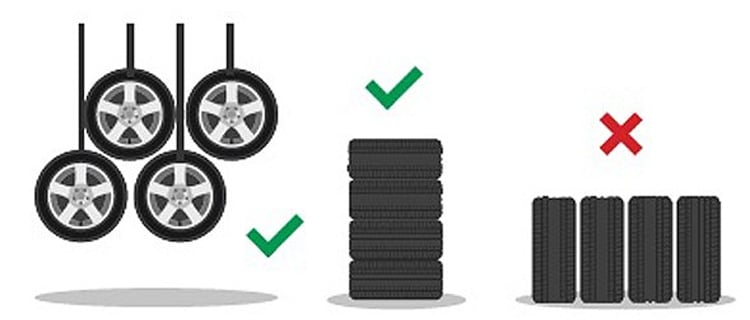Winter Tire Storage: Important Considerations And Money-Saving Tips
November 25, 2021
Tires

Don’t slack on winter tire storage. Although most modern tires are designed to resist the effects of sunlight, ozone, and water, failing to stow your tires safely and control the storage climate could lead to a serious loss of tire performance and compound integrity.
Don’t worry—TIRECRAFT is here to help. Today’s post reviews the Tire Industry Association’s “Best Management Practices for Proper Tire Storage” to help Canadians save money and eliminate winter tire storage stress.
Read on to learn more, or contact your local TIRECRAFT to take advantage of winter tire storage solutions near you.
Winter Tire Storage: Important Considerations And Money-Saving Tips
1.Choose the right winter tire storage space. “Stores tires in a clean, cool, dry, dark area, away from direct sunlight,” states the Tire Industry Association (TIA). “The area should be well ventilated, but with a minimum of circulating air.”
For most readers, that means clearing some space in the shed or garage. If you don’t have access to a space that meets these criteria, get in touch with our team to stow your tires in our secure, climate-controlled facility.
2. Clear away any hazards or contaminants. “The storage area must be kept clean and any oil, grease or water that may contaminate the tires must be removed,” states the TIA. You should also take a few minutes to remove any nails, stones, wood chips, or other hazardous debris from the storage area, and remove any pebbles or other puncture hazards that may be caught in your tread.
3. Store winter tires properly. “Tires should be stored on a pallet or storage rack to minimize exposure to moisture or damage,” states the TIA. Generally speaking, tires should be stored in an upright position, but if you must stow them in the horizontal position, be sure passenger car/light truck radial tires are stacked no higher than one meter.
Whatever you do, do not store winter tires directly on black asphalt or other heat-absorbent surfaces.
4. Keep tires away from electronics. “Store tires away from electric motors, battery charges, electric welding equipment, electric generators and similar equipment,” states the TIA. This kind of equipment emits ozone, which deteriorates rubber compounds over time.
5. Handle whitewall and raised white letter tires with care. If your tires aren’t wrapped, they should be stored with the white sidewalls facing each other to avoid staining the white through contact with the black rubber.
Book A Free Winter Tire Storage Consultation Near Me
Are you still stressed about winter tire storage? Dreading declutter duty this storage season? Worried you won’t have the time, the space, or the presence of mind to stay on top of these storage best practices?
TIRECRAFT is here to help. Whether you want to switch to an all-season or all-weather option to eliminate off-season storage and changeovers, or you want to leave your tires with us, help is only a few clicks away.
Use the Find a TIRECRAFT tool to learn more about four-season tire options and find out why so many Canadians leave their tires in our secure, monitored, and climate-controlled warehouse during the off-season.
References
Tire Industry Association (2020). Best management practices for proper tire storage.
Back

